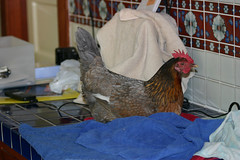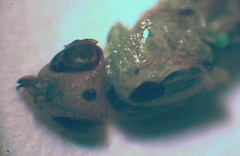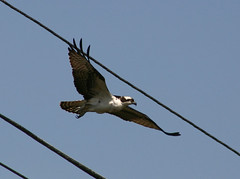Sunday, October 23, 2005
Chicken
What does Miss Chicken know about impending doom?
In the morning she is happy to see me and chortles with delight as I take her from her cage to the tool shed where I keep her corn. I take a handful and sprinkle it on the ground at the entrance to the back door. She has a special vocalization that she makes when she has found something very delicious like a worm or spider ... or her morning breakfast. The cats walk carefully around her and she watches them closely, too. Sometimes she likes to take a few mouthfuls of their dry food.
I let her roam the backyard for tiny insects. Slugs, which she grabs with deftness, throws it back into her gullet. Happy chicken. Sometimes I buy meal worms for her as treats. The happy sounds that she makes. If she is across the yard and sees me with one in my hand, she will run with her grey skirts flying to snatch the writhing larvae from my fingers.
Sometimes she gets lonesome and calls for me. She used to have a friend but she died several years ago from a heart attack. Miss Chicken hid in the bushes for days. She makes a different call to me when a hawk comes to check her out. or if stray cats come to hunt for birds. When the hawk alights on the fence she yells 'chuck chuck squawk!' If I come home too late at night and she is not at the backdoor for some reason, I hunt for her in the trees.
One night I could not find her. I looked everywhere with a flashlight. I am sure the neighbors think I am crazy. I went to bed sad knowing the raccoons sneak in my yard to hunt for fish in the pond or.... Then in a terrible squawk, with a deep throated clucking she screamed for help. The dark night made it hard for her to see. I jumped from my bed and ran out the side door to find miss chicken had gotten away once again from the jaws of the raccoons. She sat under the light outside and I picked her up. She was quiet when I put her in her cage.
So from where did this terrible H5N1 come from? I know the people in China do not think about their birds like I do - but perhaps some may. One virus or up to ten of them can cause her to be very sick and she would have less then half a chance to live. I carry her about and give her a kiss on her head, so I, too, could become sick from this disease. Where would it come from?
Doves like to clean up her corn that she does not finish. Could they carry it? At night I hear geese flying could they drop it in my yard somewhere in their excrement? Could the raccoons carry it to my yard? or the squirrels? I am in the pathway of the green parrots - could they bring it to us all?
I bought her for five dollars from a ranch not too far away from my house. I found an ad in the throw away papers. I miss not having a chicken in my backyard. She was an adult bird and sat on other birds eggs she is a brooder. She is and has always been a very personable bird and loves to follow Eddie my gardener about when he digs or trims or sweeps.... When she laid eggs, she is now past that time in her life.... she preferred the kitchen counter. To inspire her, I would put my iPod in the towel next to her. She would pull the iPod by dragging it with her 'chin' under her feathers. She would sit on the iPod until her body was ready to expel her egg.
I don't see myself not caring for this animal. What to do....
Wednesday, October 19, 2005
new secretary
Monday, October 17, 2005
Meromyza sp
This is a mangled specimen. I have been identifying insects caught on sticky traps for Mugu and the Institute of the Environment and this poor devil was a mess. Also, I have never come across this animal at Mugu on sticky traps nor sweep nets nor Malaise traps. I was stumped!! So, I asked a wonderful entomologist friend to help me out and he said it was in the family of Chloropidae.
Chloropidae. It is one of the very few I have ever seen at Mugu with so very little coloring in its exoskeleton. The haltare was turquoise simply because of the thickness of it tissues. The face was triangular, and it seemed to have a eyespot on its 'forehead.' The femur of its back leg was thick and it had stripes on the dorsal side of its thorax.
One website from Cedarcreek said it was a grass fly that liked to buzz around eyes and wounds. Another said it liked aphids. The three specimens I found on sticky traps were peppered with aphids. In fact, there were more aphids then thirps this season. And, there were more parasitic wasps then from other years.
Could have the storm events of last spring changed the configuration and abundances in the Mugu insects?
Here is a much better picture of this Meromyza sp..
http://cedarcreek.umn.edu/insects/album/029094050ap.html
I have been counting and sorting insect traps and worms from core samples of the soils from Mugu. This is the hard part. Collecting is the easy part. I love collecting and walking and finding new animals.....
Monday, October 03, 2005
Last day at Mugu

My friend and I went to Mugu on Friday, September 30. Beautiful day! But, it was our last day. So very sad. I suppose that the Navy is tired of biologists counting and assessing the plants and animals. Or maybe they are tired of scientists who watch the environment. Or could it be it is not the Navy who does not want us, but those who direct the Navy and other military bases which have the highest number of endangered organisms in the country. Perhaps, with what they do for a living - what they stand for, they hate the idea they must be stewards of important plants and animals.
My friend took this picture of me as I was looking at the different holes in the ground and walking with my net and camera. There were terrible fires in Chatsworth and Ventura the last few days. Ash was falling and drifting all over for many miles. Some of the solitary bees' holes had been usurped by spiders. Maybe, the bees were hiding deep into the ground while the spiders were borrowing the upper chambers because, there were little webs covering the holes festooned with ash.
Sunday, October 02, 2005
flying-osprey
Sitting on the electrical wire was an osprey which was watching the fish swim in the creek. My friend took this picture as I stepped out of my car.
fall--at-Mugu
The Salicornia sp. changes colors in the fall. Sometimes with orange-reds sometimes with magentas. This patch of grey-blue is a dead patch caused by a fungus.
Tiger hunting

My friend is a fine hunter of tigers.
The first step in hunting these wonderful animals is to spot them as they stand tall on their long graceful legs like slim twigs on the hot salted soils. Then, you must walk carefully - not letting your shadow cross over them because they will either disappear into the background or fly into the brush. Crouch low with your net out in front and holding the netting with your other hand... in a quiet moment wait for the tiger to clean itself.... then BLAM! Into the net. The tiger struggles in the netting. Its metallic carapace glistens in the sun. It tries to fly and then tries to find an open or torn spot in the net... You wrap the net around the struggling animal. You take the fierce tiger in your finger tips as it gnashes and slashes at you with its sharp mandibles. Such fantastic creatures!
Subscribe to:
Comments (Atom)




